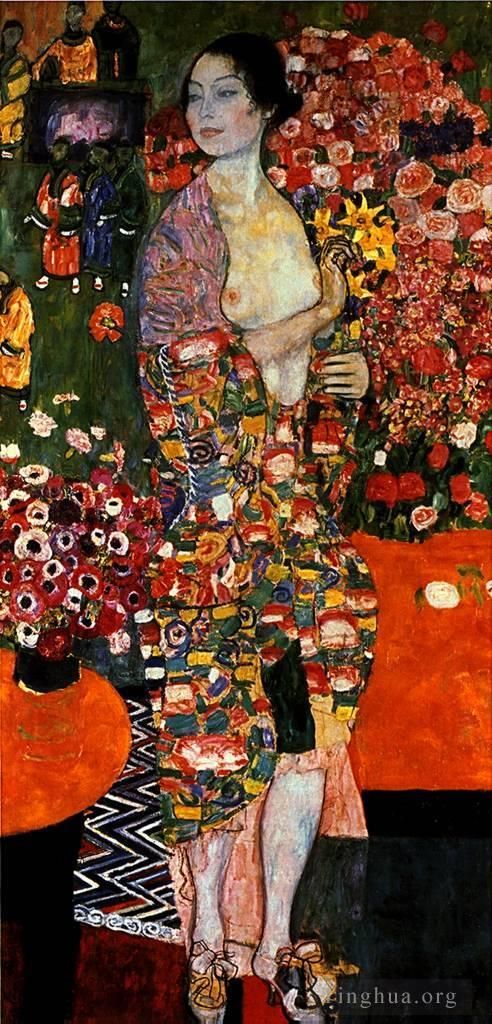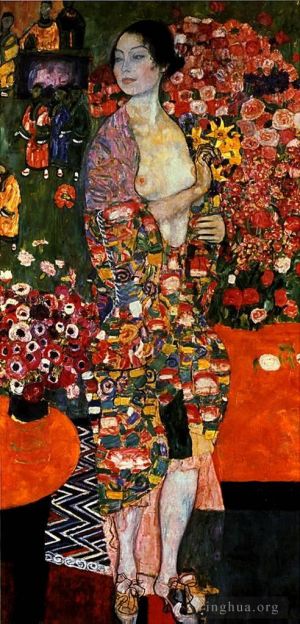The Dancer
Gustave Klimt
- Price: Price on Request
- Art Type: Oil Painting
- Size:
- English Comments: 0
- International Comments: 0
- Creating Date:
- Introduction and Works of Gustave Klimt >>
Keywords:
Dancer
Work Overview
- The Dancer
Gustav Klimt
Original Title: Die Tänzerin
Date: 1916 - 1918
Style: Art Nouveau (Modern), Japonism
Period: Late works
Genre: portrait
Measures: 180 x 90 cm
Technique: Oil on canvas
Depository: Privately owned, New York
The name dancer originates from Erich Lederer. We do not know who the lady in the painting is. There are speculations that it is Ria Munk, the daughter of Alexander and Aranka Munch (born Pulitzer) who commisioned a posthum portrait of their daughter Maria, who commited suicide after her lover left her. We know that the Munks didn't like the first portrait and they ordered another portrait. But would Klimt have depicted a portrait of a dead young woman with bare breasts? More likely ist he assumption that it is the portrait of the younger daughter Lola.
With a distinctly oriental and sensual feel, this beautiful image features a young woman, her head turned to the side, holding a bunch of bright yellow daffodils.
Just behind her are a group of anonymous figures, who also appear to be wearing oriental style clothing. The woman's clothing is open, exposing her breasts and the colourful gown she is wearing blends into the background in a riot of floral patterns and colours.
This was characteristic of Klimt's later pieces where anatomy and ornamentation almost become one. Her black pantaloons are just visible and on her feet she wears highly detailed shoes with the fashionable Louis heels of the time, decorated with bows.
Klimt was fascinated with "oriental" culture. He owned a collection of books about the East and a wardrobe of Japanese and Chinese costumes too.
Additionally, Klimt would have been well aware of feminine fashions due to his close friendship with fashion designer, Emilie Floge as he had drawn some fashion items for her salon too.
Although it is not clear who the woman in the painting is, it seems that the inspiration came about through a failed commission. He had been asked to paint a second portrait of Aranka Munk's deceased daughter Ria Munk.
However, Klimt struggled with the painting which was supposed to depict Ria's "joie de vivre" when she was alive, rather that the deathbed version he had already completed.
Klimt wrote to his companion, Emilie, that he couldn't make the "likeness" and his image of the client's daughter was finally rejected. Klimt went on to complete the painting, portraying the bare-breasted, alluring female now known as The Dancer.
It has been suggested that he based the portrait on one of his models, possibly a dancer.
The Dancer is a wonderful, colourful vision capturing Klimt's talent and unique style, just before his death in 1918.
- Copyright Statement:
All the reproduction of any forms about this work unauthorized by Singing Palette including images, texts and so on will be deemed to be violating the Copyright Laws.
To cite this webpage, please link back here.
- >> English Comments
- >> Chinese Comments
- >> French Comments
- >> German Comments
- >>Report
- Woman in Gold
- Portrait of Adele Bloch-Bauer I
- Stiller Weiherim Schlobparkvon Kammer
- The Beethoven Frieze 1902
- Water Snakes II(Water Serpents II)
- Malcesine am Gardasee (Malcesine on Lake Garda)
- Portrait of Adele Bloch-Bauer II
- Buchenhain
- Portrat der Fritza Riedler
- Gartenmit Huhnernin StAgatha
- Sonja Knips
- Nuda Veritas
- Avenue of Schloss Kammer Park
- Bauernhausin Oberosterreich
- Bildnis Fritza Riedler 1906
- Judith
- Die Musik
- Minerva or Pallas Athena
- The Kiss
- Houses at Unterach on the Attersee
- Portrait of a Lady
- Die Liebe
- Two Girls With An Oleander
- Fable
- Gold fish
- Farmhouse with Birch Trees
- Design for the Stocletfries
- Church in Unterach on the Attersee (Church in Unterach on Lake Attersee)
- Gartenmit SonnenblumenaufdemLande
- Chruch in Cassone
- Pine Forest II
- University of Vienna Ceiling Paintings
- Mohnfeld
- Fredericke Maria Beer
- Apple Tree II
- Farm Garden with Crucifix
- Portrateiner Dame
- The Virgin (The Maiden)
- Landscape Garden Meadow in Flower
- Dame mit Cape 1897
- Beech Grove I (Beech Forest I)
- The Girl friends (The Lesbians)
- Lady with Fan 2
- Der Beethovenfries Wandgemaldeim Sezessionshausin Wienheuteosterr 2
- Garden with Roosters (Garden Path with Chickens)
- Water Snakes (Watersnakes I or Water Serpents I)
- Danae (Danaë)
- Lady with Fan
- Apple Tree I
- Portrait of Hermine Gallia
- Portrait of a Lady 3
- The Virgins
- The Big Poplar II
- Baby
- The Dancer
- Flower Garden (Farm Garden)
- The Sunflower
- Schlob Kammeram Attersee
- Portratder Friederike Maria Beer
- Love 1895
- Teas in Klimt Style
- Lakeside with Birch Trees
- Reclining Nude Lying on Her Stomach and Facing Right
- Portrait Of Eugenia Primavesi
- Die Grobe Pappeloder Aufziehendes Gewitter
- Portrat der Margaret Stonborough Wittgenstein
- Fir Forest I
- Park of Schönbrunn (Schönbrunn Palace Garden)
- Water Castle
- Death and Life
- Schubert at the piano I
- Farmhouse in Upper Austria
- Baby 3
- Amalie Zuckerkandl
- Portrat der Maria Munk
- Portrait of a Girl
- Emilie Floge Aged 17
- Portratder Baroness Elisabeth BachofenEcht
- Italian horticultural landscape
- Portrait of Gertha Felssovanyi
- Hope I
- Blooming field
- The Beethoven Frieze The Longing for Happiness Finds Repose in Poetry
- The House of Guardaboschi
- Schloss Kammer on the Attersee IV
- Fruit Trees
- Mada Primavesi c 1912
- The Women Friends
- Mother with Children
- Portrait of Serena Lederer
- Roses under the Trees
- Bildnis Margaret Stonborough Wittgenstein 1905
- Bewegte Wasser
- Lady with Hat and Featherboa
- After the Rain Garden with Chickens in St Agatha
- Country House by the Attersee
- The Beethoven Frieze The Hostile Powers Far Wall
- Portrait of Emilie Floge 2
- Portrait of Marie Breunig
- Untitled landscape
- Derschwarze Hut
- The Swamp
- Portrait of Helene Klimt
- Der Beethovenfries Wandgemaldeim Sezessionshausin Wienheuteosterr 4
- Portrait of Emilie Floge
- Portratdes Schauspielers Josef Lewin skyals Carlos
- Baby 2
- Judith and the Head of Holofernes
- Mulhersentada
- The Three Ages of Woman
- Adam and Eva
- Horticultural landscape with a hilltop
- Hope II
- Sapho
- Kuheim Stall
- Portrait of Baroness Elisabeth Bachofen Echt red
- The Tree of Life Stoclet Frieze
- Island in the Attersee
- Farm Houses with Birch Trees
- Schloss Kammer am Attersee II
- Das Hausvon Guardaboschi
- Girl with Long Hair with a sketch for Nude Veritas
- Fishblood
- Allegory of Sculpture
- Idylle 1884
- Januar









 Singing Palette
Singing Palette